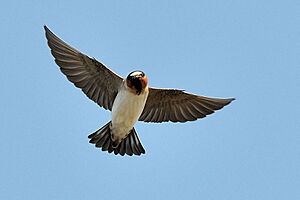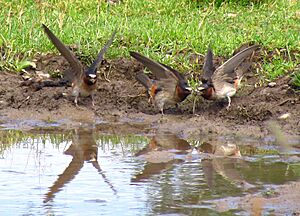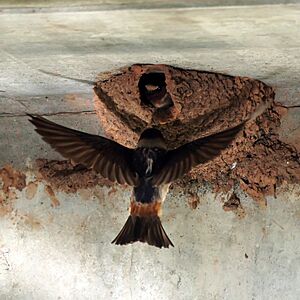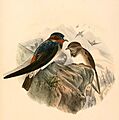Cliff swallow facts for kids
Quick facts for kids Cliff swallow |
|
|---|---|
 |
|
| At Palo Alto Baylands NR, California, US | |
| Conservation status | |
| Scientific classification | |
| Genus: |
Petrochelidon
|
| Species: |
pyrrhonota
|
 |
|
| Approximate distribution map
Breeding Migration Nonbreeding |
|
| Synonyms | |
|
Petrochelidon lunifrons |
|
The cliff swallow (Petrochelidon pyrrhonota) is a small, social bird. It belongs to the swallow and martin family. Its scientific name comes from Ancient Greek words. Petrochelidon means "stone swallow," and pyrrhonota means "flame-colored back."
Cliff swallows are very social songbirds. They live in huge groups called colonies. Some colonies can have over 2,000 nests! You often see them flying in large flocks. They fly gracefully, catching insects or resting together on wires.
These birds build unique, gourd-shaped nests. They use mud and make a small entrance hole. They build their nests close together, often under bridges or on mountain cliffs. Living in big groups, they use many different calls. These calls help them warn others of danger or share where food is.
Contents
What Do Cliff Swallows Look Like?
Cliff swallows are about 13 centimeters (5 inches) long. They have short legs and small beaks. Their wings are long and pointed. Adult birds have dark brownish feathers on their backs and wings. They have a white forehead and reddish cheeks. Their throats are dark, and their bellies are white. Their rump (the area above their tail) is a buffy color.
In good light, their heads and back feathers can look shiny. Cliff swallows from the northern areas are a bit bigger. They also have different face markings than those from Mexico. Mexican cliff swallows have a chocolate-brown patch on their foreheads.
Male and female cliff swallows look almost the same. During the breeding season, females might lose feathers on their chest. This creates a warm spot for sitting on their eggs. Cliff swallows look a bit like barn swallows. But cliff swallows have a square-shaped tail, not a forked one.
Young cliff swallows look similar to adults. But their colors are paler. They don't have the shiny feathers of adults. Their foreheads and throats look speckled white. These white face markings help parents recognize their own chicks. These markings change as the young birds grow up.
Where Do Cliff Swallows Live?
Cliff swallows used to build their nests mainly on mountain cliffs. This is how they got their name. But now, they are very adaptable birds. They have learned to build nests on human structures. You can find them nesting under bridges and on buildings. This has helped them spread across Canada and the United States.
Most nesting colonies are near open fields or ponds. These places have lots of flying insects for them to eat. This is very important during their breeding season.
When winter comes, cliff swallows fly south. They travel long distances to South America. They can be found in southern Brazil, Uruguay, and parts of Argentina. They fly along the North American coastlines. Eastern birds fly through Florida, and western birds fly through Mexico. Large groups migrate together.
The Swallows of Capistrano
The cliff swallows are famous for their trip to San Juan Capistrano, California. They nest at the church of Mission San Juan Capistrano. Their yearly return is a big cultural event there. A song from 1940, "When the Swallows Come Back to Capistrano," celebrates this special event.
How Do Cliff Swallows Behave?
Cliff swallows live in large colonies during breeding season. Living in a group has good and bad points. They can share important information, like where to find food. But living close together also makes it easier to spread parasites or diseases. Cliff swallows can get many parasites, like ticks and fleas. These parasites can slow down the growth of young birds.
Cliff swallows are usually monogamous. This means one pair takes care of each nest. But sometimes, a male or female might mate with more than one bird. This helps increase the variety of genes in the colony. Cliff swallows are known for being "aggressive and fearless." This is different from their relatives, the barn swallows, who are more timid.
What Do Cliff Swallows Eat?
Cliff swallows eat flying insects. They especially like insects that swarm. This includes flies, bees, lacewings, and butterflies. They hunt high above fields or marshes. They often rely on water bodies like ponds during windy weather. These birds hunt during the day (diurnal). They return to their nests at dusk. They are not very active when it's cold or rainy. This is because there are fewer insects to catch.
When they first arrive at their nesting site, they fly far to find food. This helps them build up energy for laying eggs. When swallows return to their nests at dusk, they often fly in a tight, coordinated group. These large groups are called creches.
Cliff swallows also share food information. They use special calls to tell others where there's a good food spot. When a bird makes this call, many others from the colony will fly to that location. This call is especially useful during bad weather.
How Do Cliff Swallows Communicate?
Cliff swallows have a complex system of calls. Both young and adult birds use five main types of calls. These include begging calls, alarm calls, and calls for recognition.
Young cliff swallows develop a unique call around 15 days old. This helps their parents find them among all the other chicks.
The "squeak" call is very interesting. A bird makes this call when it finds a good place to hunt. When others hear it, many birds from the colony will join them. This is one of the few times animals share food information with others.
Alarm calls are heard near the nests. They warn other birds about danger. When an alarm call is heard, many birds will fly out of their nests and away from the danger.

How Do Cliff Swallows Reproduce?
The breeding season begins when cliff swallows return from their winter homes. They arrive in large groups and pick their nesting spots. Sometimes, they skip a year or more before breeding in the same place. This helps them avoid too many parasites. Younger birds often do better in larger colonies. They can learn valuable information from the group. Older birds might nest earlier, avoiding the hot mid-summer when parasites are worse.
When they arrive, cliff swallows decide whether to fix an old nest or build a new one. Building a new nest means fewer parasites. But it takes a lot of energy and time. This can mean reproducing later, which might be harder for their chicks. Nests made with sticky clay can last for years. Cliff swallows often collect mud together for nest building. They carry mud in their beaks back to their nests.
Each pair usually has 3 to 4 chicks per brood. A clutch of 4 eggs is most common and successful. Female cliff swallows sometimes lay their eggs in other nests. This is called "brood parasitism." Females who do this often have more successful reproduction. The "victims" of this have to raise more chicks. This takes more energy and means they are raising young that are not their own. Male cliff swallows also mate with more than one female. This also helps spread genes throughout the colony.
Other birds, like the house sparrow, can take over swallow nests. House sparrows look for nests to make their own. They might destroy many swallow eggs in the process. Nests on the edges of colonies are also open to snakes. Nests in the middle are safer and often have more eggs.
Once house sparrows pick a nest, they fill it with grass. This makes it impossible for the swallows to use it again. Colonies with house sparrows often have fewer successful nests.
Images for kids










